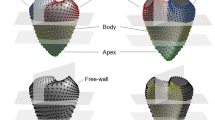Abstract
The body surface isopotential T map was analyzed to detect right ventricular volume and pressure overloads in 25 patients with secundum atrial septal defect. Three patterns were distinguished: a T map resembling normal (type A,n=9); that with an isolated negative area in a positive area (type B,n=11); and that with rightward movement of maximum (type C,n=5). Right ventricular end-diastolic volumes in types B (161±19% of normal; %N) and C (175±40%N) were significantly (p<0.01) greater than those in controls (100±9%N) and type A (113±18%N). Right ventricular systolic pressure in type C (48±11 mmHg) was significantly (p<0.01) higher than those in the controls (30±5 mmHg), type A (31±4 mmHg), or type B (34±5 mmHg). These results suggest that the patients with type B have right ventricular volume overload and those with type C have both volume and pressure overloads.
Similar content being viewed by others
References
Abildskov JA, Green LS, Evans AK, Lux RL (1982) The QRST deflection area of electrograms during global alterations of ventricular repolarization.J Electrocardiol 15:103–108
Asai T, Nagai N, Nakashima T, Nagashima M, Hayashi H (1991) Estimation of the right ventricular volume overload in children with atrial septal defect by body surface mapping.Jpn Circ J 55:262–270
Awa S, Linde LM, Oshima M, et al (1970) The significance of late-phased dart T wave in the electrocardiogram of children.Am Heart J 80:619–628
Awa S, Linde LM, Oshima M, et al (1971) Isolated T-wave inversion in the electrocardiogram of children.Am Heart J 81:158–165
Benson DW, Spach MS (1982) Evolution of QRS and ST-T-wave body surface potential distributions during the first year of life.Circulation 65:1247–1258
Chapman CB, Baker O, Reynolds J, Bonte FJ (1958) Use of biplane cinefluorography for measurement of ventricular volume.Circulation 18:1105–1117
Graham TPJ, Jarmakani JM, Atwood GF, Canet RVJ (1973) Right ventricular volume determinations in children: normal values and observations with volume or pressure overload.Circulation 47:144–153
Izumida N, Kiyohara K, Asano Y, et al (1993) The body surface isointegral maps in infants with right ventricular overload.Jpn Circ J 57:123–130
Kinoshita A, Ohta T, Hirai M, et al (1984) Body surface isopotential maps of normal Japanese children.Jpn Circ J 48:484–491
Montague TJ, Smith ER, Cameron DA, et al (1981) Isointegral analysis of body surface maps: surface distribution and temporal variability in normal subjects.Circulation 63:1166–1172
Nakasato M (1994) Left and right ventricular volume characteristics and regional wall motion in children with secundum atrial septal defect.Jpn J Pediatr 98:1212–1220 (in Japanese with English abstract)
Shimazaki Y, Kawashima Y, Mori T, Beppu S, Yokota K (1980) Angiographic volume estimation of right ventricle: reevaluation of the previous method.Chest 77:390–395
Suzumiya H, Matsuoka Y, Hayakawa K (1988) Body surface isopotential maps during the first week of life.J Electrocardiol 21:15–24
Tsuchiya S (1989_ Body surface maps during ventricular repolarization in children with secundum type ASD.Acta Cardiol Paediatr Jpn 5:277–285 (in Japanese with English abstract)
Yamada K (1981) Body surface isopotential map, past, present, and future.Jpn Circ J 45:1–14
Author information
Authors and Affiliations
Rights and permissions
About this article
Cite this article
Nakasato, M., Akiba, T., Sato, S. et al. Body surface isopotential T map for assessment of right ventricular volume and pressure overloads in secundum atrial septal defect. Pediatr Cardiol 17, 237–241 (1996). https://doi.org/10.1007/BF02524800
Issue Date:
DOI: https://doi.org/10.1007/BF02524800




